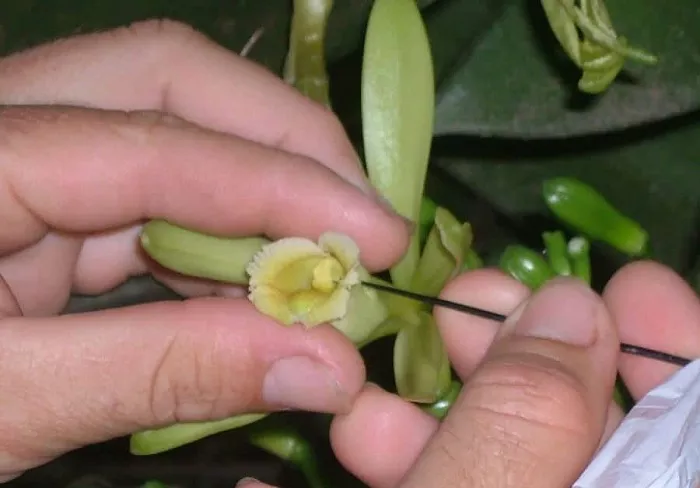Pollinating vanilla orchid flowers is an art that can transform your garden into a fragrant haven. This delicate process requires patience and precision, but the reward is the sweet scent of blooming vanilla. In this guide, we will explore the intricacies of pollinating these enchanting flowers, ensuring a fruitful and fragrant harvest.
Understanding the Vanilla Orchid
The vanilla orchid, or Vanilla planifolia, is a captivating plant known for its unique flowers and the precious vanilla beans it produces. Native to Central America, this orchid thrives in warm, humid climates and requires specific conditions to bloom and produce fruit. Understanding its natural habitat and growth patterns is crucial for successful pollination.
The Anatomy of a Vanilla Orchid Flower
Each vanilla orchid flower is a marvel of nature. The flower consists of several key parts: the anther, which produces pollen; the stigma, where the pollen must be deposited; and the rostellum, a protective structure that separates the anther and stigma. Unlike many other flowers, the vanilla orchid’s anther and stigma are not naturally positioned for self-pollination, making hand-pollination essential.
The Importance of Pollination
Pollination is the process of transferring pollen from the anther to the stigma. For vanilla orchids, this step is vital for fertilization and the development of vanilla beans. In the wild, vanilla orchids are pollinated by specific species of bees and hummingbirds. However, in cultivation, especially in regions outside their native habitat, hand-pollination becomes necessary to ensure fruit set.
Preparing for Pollination
Before you begin the pollination process, it’s important to prepare your vanilla orchid and your tools. Proper preparation can significantly increase the success rate of pollination.
Choosing the Right Time
Timing is crucial when it comes to pollinating vanilla orchids. The flowers typically bloom in the early morning and remain open for only a day. Therefore, it’s essential to check your orchid regularly for signs of blooming. The best time to pollinate is within a few hours of the flower opening, usually between 6 a.m. and 10 a.m.
Gathering Your Tools
Hand-pollinating vanilla orchids requires a few simple tools. You will need a small, clean pair of tweezers and a thin, pointed tool such as a toothpick or a fine brush. These tools will help you manipulate the delicate flower parts without causing damage.
Ensuring Proper Conditions
Vanilla orchids thrive in specific environmental conditions. Ensure that your orchid is receiving the right amount of light, water, and humidity. A healthy plant is more likely to produce flowers and successfully set fruit after pollination.
The Pollination Process
Pollinating vanilla orchids is a delicate task that requires careful handling and attention to detail. Follow these steps to ensure successful pollination.
Accessing the Flower Parts
Using your tweezers, gently lift the rostellum to expose the anther and stigma. Be very careful not to damage the flower parts. The rostellum acts as a barrier, and lifting it correctly is essential for successful pollination.
Collecting Pollen
Once the anther is exposed, use your toothpick or fine brush to collect pollen from the anther. Gently scrape the pollen onto the tip of your tool. Be sure to gather enough pollen to ensure successful transfer.
Depositing Pollen
Carefully transfer the collected pollen to the stigma. Gently rub the pollen onto the stigma, ensuring that it makes good contact. The stigma should be sticky, which helps the pollen adhere. After depositing the pollen, gently replace the rostellum to protect the flower.
Monitoring for Success
After pollination, it’s important to monitor the flower for signs of successful fertilization. If the flower has been successfully pollinated, it will begin to wilt within a few days. Within a week or two, you should see the start of a vanilla bean developing at the base of the flower.
Common Challenges and Solutions
Pollinating vanilla orchids can be challenging, but with patience and practice, you can overcome common obstacles.
Flower Drop
One common issue is flower drop, where the flowers fall off before they can be pollinated. This can be caused by improper environmental conditions, such as insufficient light or humidity. Ensure that your orchid is receiving the right care to prevent flower drop.
Pollination Failure
Sometimes, despite careful pollination, the flowers may not set fruit. This can be due to insufficient pollen transfer or poor environmental conditions. Double-check your pollination technique and ensure that your orchid is healthy and well-maintained.
Pest and Disease Management
Pests and diseases can also affect the success of pollination. Keep an eye out for common orchid pests such as mealybugs and spider mites. Regularly inspect your plants and treat any issues promptly to ensure a healthy environment for pollination.
Caring for Your Vanilla Orchid After Pollination
Once your vanilla orchid has been successfully pollinated, proper care is essential for the development of healthy vanilla beans.
Water and Humidity
Maintain consistent watering and humidity levels. Vanilla orchids require a humid environment to thrive. Mist your plants regularly and ensure they are not exposed to direct sunlight, which can dry out the leaves and beans.
Fertilization
Provide your orchid with a balanced fertilizer during the growing season. This will help support the development of the vanilla beans and ensure a healthy harvest.
Harvesting Vanilla Beans
Vanilla beans are typically ready for harvest about nine months after pollination. The beans should be plump and dark green when they are ready. Harvest them carefully and begin the curing process to develop their rich, aromatic flavor.
Conclusion
Pollinating vanilla orchid flowers is a rewarding process that brings the beauty and fragrance of nature into your garden. With patience, precision, and proper care, you can enjoy the delightful scent of blooming vanilla and the satisfaction of a successful harvest. Whether you are a seasoned gardener or a novice, the art of pollinating vanilla orchids is a journey worth taking.


